
The Almoravid dynasty was an imperial Berber Muslim dynasty centered in the territory of present-day Morocco. It established an empire in the 11th century that stretched over the western Maghreb and Al-Andalus, starting in the 1050s and lasting until its fall to the Almohads in 1147. The Almoravid capital was Marrakesh, a city founded by the Almoravid leader Abu Bakr ibn Umar c. 1070. The dynasty emerged from a coalition of the Lamtuna, Gudala, and Massufa, nomadic Berber tribes living in what is now Mauritania and the Western Sahara, traversing the territory between the Draa, the Niger, and the Senegal rivers.

Abu Bakr Abdullah ibn Uthman Abi Quhafa was the senior companion and was, through his daughter Aisha, a father-in-law of the Islamic prophet Muhammad, as well as the first Caliph of the Rashidun Caliphate. He is known with the honorific title "al-Siddiq" by Sunni Muslims.

Musa I was the ninth mansa of the Mali Empire, which reached its territorial peak during his reign. Musa is known for his wealth and generosity. He has been subject to popular claims that he is the wealthiest person in history, but his actual wealth is not known with any certainty. His riches came from the mining of significant gold and salt deposits in the Mali Empire, along with the slave and ivory trade.

Medieval Muslim Algeria was a period of Muslim dominance in Algeria during the Middle Ages, spanning the millennium from the 7th century to the 17th century. The new faith, in its various forms, would penetrate nearly all segments of society, bringing with it armies, learned men, and fervent mystics; in large part, it would replace tribal practices and loyalties with new social norms and political idioms.
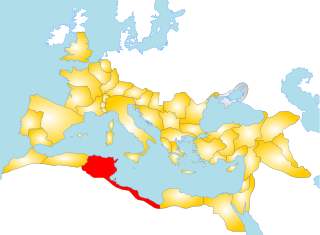
Ifriqiya, also known as al-Maghrib al-Adna, was a medieval historical region comprising today's Tunisia and eastern Algeria, and Tripolitania. It included all of what had previously been the Byzantine province of Africa Proconsularis and extended beyond it, but did not include the Mauretanias.
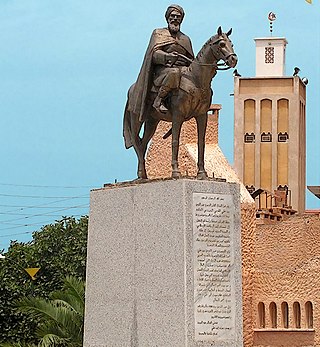
Abd al Mu'min was a prominent member of the Almohad movement. Although the Almohad movement itself was founded by Ibn Tumart, Abd al-Mu’min was the founder of the Almohad dynasty and creator of the dynasty's empire. As a leader of the Almohad movement he became the first Caliph of the Almohad Empire in 1133, after the death in 1130 of the movement's founder, Ibn Tumart, and ruled until his death in 1163. Abd al-Mu'min put his predecessor's doctrine of Almohadism into practice, defeated the Almoravids in present-day Morocco, and extended his rule across Al-Andalus and as far as Tunis in Ifriqiya, thus bringing the Maghreb in North Africa and Al-Andalus in Europe under one creed and one government.

Azougui was a town in north western Mauritania, lying on the Adrar Plateau, north west of Atar. In the eleventh century it was the first capital of the Almoravid dynasty, who conquered a territory stretching from the Ghana Empire to Morocco and the Iberian Peninsula.

Abu Bakr ibn Umar ibn Ibrahim ibn Turgut, sometimes suffixed al-Sanhaji or al-Lamtuni was a chieftain of the Lamtuna Berber Tribe and Amir of the Almoravids from 1056 until his death. He is credited to have founded the Moroccan city of Marrakesh, and under his rule the heretic Barghawatas were destroyed. In 1076, he conquered Koumbi Saleh capital of the Ghana Empire, and is credited to have brought Islam in this Western Sub-Saharan Africa region. In November of 1087, Abu Bakr died of a poisoned arrow in Senegal.

Yusuf ibn Tashfin, also Tashafin, Teshufin, was leader of the Berber Almoravid empire. He co-founded the city of Marrakesh and led the Muslim forces in the Battle of Sagrajas. Yusuf ibn Tashfin came to Al-Andalus from the Maghreb to help the Muslims fight against Alfonso VI, eventually achieving victory in Sagrajas and promoting an Islamic system in the region. In 1061 he took the title “Amir al-Muslimeen” recognising the suzerainty of the Abbasid Caliphate. He was married to Zaynab an-Nafzawiyyah, whom he reportedly trusted politically.
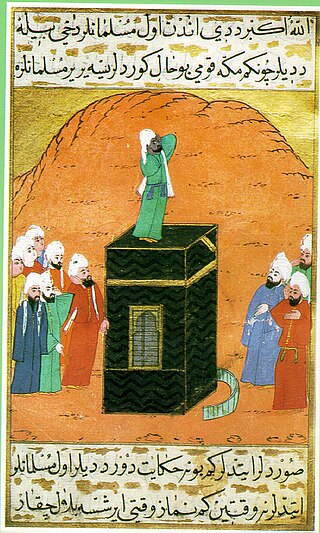
Bilāl ibn Rabāḥ, c. 580–640, was one of the most trusted and loyal Sahabah (companions) of the Islamic prophet Muhammad. He was born in Mecca and is considered to have been the first mu'azzin in history, chosen by Muhammad himself. He was a former Abyssinian slave and was known for his voice with which he called people to their prayers. He died in 640, about the age of 60.
Abdallah ibn Yasin was a theologian and spiritual leader of the Almoravid movement.
Tunka Manin (1010–1078) was a ruler of the Ghana Empire who reigned from 1062 to 1076 C.E. Preceded by Ghana Bassi, Manin was the last ruler of the Ghana Empire before the Almoravid conquest. Accounts of Tunka Manin come from al-Bakhri, a visitor to the China kingdom who described him as a "lover of justice and favorable to Muslims".

The Rashidun Caliphate was the first caliphate to succeed the Islamic prophet Muhammad. It was ruled by the first four successive caliphs of Muhammad after his death in 632 CE. During its existence, the empire was the most powerful economic, cultural, and military force in West Asia.
Aghmat was an important commercial medieval Berber town in Morocco. It is today an archaeological site known as "Joumâa Aghmat".
Zaynab an-Nafzāwiyyah, was a Berber woman of influence in the early days of the Almoravid Berber empire which gained control of Morocco, Algeria, and parts of Spain.
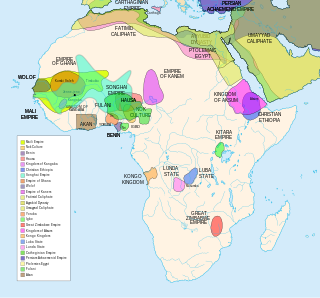
African empires is an umbrella term used in African studies to refer to a number of pre-colonial African kingdoms in Africa with multinational structures incorporating various populations and polities into a single entity, usually through conquest.

Precolonial Mauritania, lying next to the Atlantic coast at the western edge of the Sahara Desert, received and assimilated into its complex society many waves of Saharan migrants and conquerors.
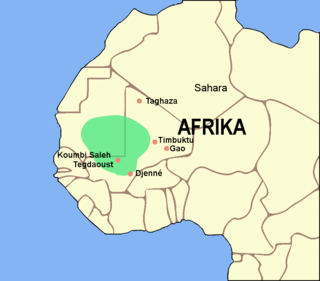
The Ghana Empire, also known as Wagadou or Awkar, was a West African empire based in the modern-day southeast of Mauritania and western Mali that existed from c. 300 until c. 1100. The Empire was founded by the Soninke people, and was based in the capital city of Koumbi Saleh.
The French conquest of Senegal started in 1659 with the establishment of Saint-Louis, Senegal, followed by the French capture of the island of Gorée from the Dutch in 1677, but would only become a full-scale campaign in the 19th century.
Abu Zakariyya Yahya ibn Umar ibn Talagagin ibn Turgut ibn Wartasin, commonly suffixed al-Lamtunial-Sanhaji, was a chieftain of the Lamtuna, a tribe in the Sanhaja confederation. Yahya ibn Umar was the first emir of the Almoravids in the mid-11th century, a movement he constructed in collaboration with the religious leader Abdallah ibn Yasin. Yahya led the Almoravid armies in their first campaigns, including captures of Sijilmassa and Awdaghost in 1054/55, but was himself killed in battle against a dissident Berber faction in the Adrar. Yahya was succeeded as Almoravid emir by his brother, Abu Bakr ibn Umar.













